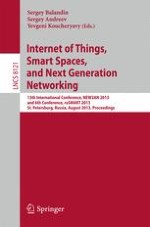This book constitutes the joint refereed proceedings of the 13 International Conference on Next Generation Teletraffic and Wired/Wireless Advanced Networking, NEW2AN, and the 6th Conference on Internet of Things and Smart Spaces, ruSMART 2013, held in St. Petersburg, Russia, in August 2013. The total of 38 papers was carefully reviewed and selected for inclusion in this book. The 14 papers selected from ruSMART are organized in topical sections named: internet on things, smart spaces technologies; and smart systems. The 24 papers from NEW2AN deal with the following topics: performance and efficiency analysis, network and transport layer issues; cognitive radio networks; sensor and mesh networks; upper layer protocols and applications; ad-hoc, cellular and satellite networks.
